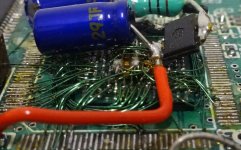I have come back on this thread from the MOSFET controversy on another.
Lamp builders beware the reverse polarity protection diode on the Chinese drivers!
There for good reason, as all these drivers are generic to torches, bike lamps, head torches and whatever, where the user loads in loose batteries. Obviously, nothing to prevent some fool putting them in backwards, hence the diode. problem is that efficiency goes down due to the 0.33V (approx) Vf drop on Schottky Diode. Hope they do use Schottky, not ordinary diodes, they much worse!
So, if say 1 amp is going through it, you loose 0.33 watts as heat. So if not needed, remove.
So, to MOSFETS. If you must have reverse polarity protection you can use a MOSFET wired backwards. So its Drain to voltage in, Source to load. Gate is still either P signal or N signal as appropriate to the diode. N needs gate P, P needs gate N. Credit where its due, I learned this many years ago from Mr Mike.
Now, a question for Chris JC, he is bound to read this.
I have spent hours trawling through data sheets and have found an alternative low Rds MOSFET.
I have been seeing product descriptions on RS Online that do not agree with data sheet. Descriptions are giving stuff like Rds = 0.0016 ohms, and data sheet clearly states 1.6 ohms, a bit high for a MOSFET. Data sheet clearly states Ohms not milliohms.
Any ideas?
Of course, this is relevant to their use as a RP protection, it also explains why on a lot of the Chinese off-the-shelf drivers you have massive 40 amp switching diodes.




